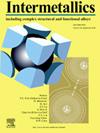Amorphization and energy maps of mechanically alloyed FeSiB-based alloys
IF 4.3
2区 材料科学
Q2 CHEMISTRY, PHYSICAL
引用次数: 0
Abstract
In this research work, the effect of different mechanical alloying processing parameters such as ball-to-powder weight ratio (BPR), size of the milling balls, rotation speed, and milling duration on the amorphization of an elemental blend of iron (Fe), silicon (Si), and boron (B) have been studied. FeSiB powder alloys were obtained by mechanically alloying of elemental powders for 10, 20, and 30 h with a rotation speed of 700 rpm, stearic acid as process control agent (PCA), and the ball-to-powder ratio of 5:1, 10:1, and 15:1. The resultant powders were then consolidated using the spark plasma sintering (SPS) technique. The effect of SPS processing parameters on mechanical and magnetic properties was studied. For samples milled under the same conditions, the saturation magnetization of the samples sintered at higher temperatures was proven to be higher. Moreover, the effect of heat treating the amorphous powder alloy before SPS processing was studied. The results showed an increase in the saturation magnetization of the heat-treated samples but also an increase in coercivity. Finally, the energy maps were drawn for mechanically alloyed FeSiB-based samples milled under different conditions to find the window for the total energy and minimum energy of a single ball that would give us an amorphous structure useful for magnetic properties.
求助全文
约1分钟内获得全文
求助全文
来源期刊

Intermetallics
工程技术-材料科学:综合
CiteScore
7.80
自引率
9.10%
发文量
291
审稿时长
37 days
期刊介绍:
This journal is a platform for publishing innovative research and overviews for advancing our understanding of the structure, property, and functionality of complex metallic alloys, including intermetallics, metallic glasses, and high entropy alloys.
The journal reports the science and engineering of metallic materials in the following aspects:
Theories and experiments which address the relationship between property and structure in all length scales.
Physical modeling and numerical simulations which provide a comprehensive understanding of experimental observations.
Stimulated methodologies to characterize the structure and chemistry of materials that correlate the properties.
Technological applications resulting from the understanding of property-structure relationship in materials.
Novel and cutting-edge results warranting rapid communication.
The journal also publishes special issues on selected topics and overviews by invitation only.
 求助内容:
求助内容: 应助结果提醒方式:
应助结果提醒方式:


